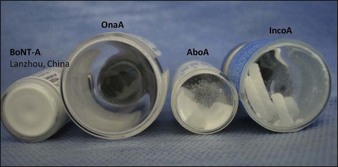11 Reconstitution / Dilution
Summary and Key Features
• Prescribing information on all available products recommends reconstitution in unpreserved saline
• Studies in the literature suggest that other solutions can be used such as preserved saline, anesthetics (lidocaine or bupivacaine), with or without epinephrine and albumin
• In vivo studies demonstrate that onabotulinumtoxinA is not as fragile as originally thought and that foam during reconstitution does not inactivate the toxin
• Although manufacturers recommend storage at 2–8°C in the refrigerator, toxin administration within 4–24 hours, and avoiding freezing after reconstitution, it appears that some products can be stored for longer periods of time after reconstitution, in the refrigerator or the freezer, without loss of efficacy or contamination
• In regard to the best dilution to be used, when treating limb muscles, perhaps as a result of greater dispersion of the toxin, higher dilutions might be beneficial
• For facial muscles, more concentrated volumes are preferred, since they produce less discomfort for patients
• The literature suggests that toxins may be more sturdy and resistant to degradation than previously understood
Reported substances used in the reconstitution process
OnabotulinumtoxinA is provided as a vacuum-dried powder, whereas incobotulinumtoxinA, abobotulinumtoxinA, and BoNT-A from Lanzhou (China) are presented as lyophilized powders (Fig. 11.1). RimabotulinumtoxinB is provided as a ready-to-use sterile liquid and no reconstitution is required.

Figure 11.1 Appearance of various vacuum-dried and lyophilized BoNT-A powder products, before reconstitution.


















